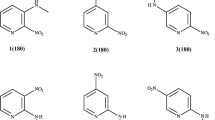Abstract
The signals of all of the protons in the PMR spectrum of 2,4-dimethyl-1H-benzo-1,5-diazepine hydrochloride are shifted to stronger fields by 0.5–1.0 ppm relative to the signals of the analogous protons in model compounds. This shift is explained by the considerable paramagnetic contribution of the eight π electrons of the diazepine ring of the 1H-benzo-1,5-diazepinium monocation to the magnetic susceptibility of the molecule. Calculations of the π-electron ring current and the π-electron component of the magnetic susceptibility of this monocation by the MO LCAO method showed that the ring current in the seven-membered ring is paramagnetic and depends markedly on the magnitude of the coulombic integral for nitrogen.
Similar content being viewed by others
Literature cited
W. J. Barry, I. L. Finar, and E. F. Mooney, Spectrochim. Acta, 21, 1095 (1965).
H. Staab and F. Vögtle, Ber., 98, 2701 (1965).
C. E. Johnson and F. A. J. Bovey, J. Chem. Phys., 29, 1012 (1958).
B. P. Dayley, A. Gawer, and W. C. Neikam, Disc. Faraday Soc., 34, 18 (1962).
J. A. Pople, Mol. Phys., 1, 175 (1958).
A. Streitwieser, Molecular Orbital Theory for Organic Chemists, Wiley (1961).
Ya. G. Dorfman, Diamagnetism and the Chemical Bond [in Russian], Gos. Izd. Fiz.-Mat. Lit., Moscow (1961), p. 26.
G. Berthier, M. Mayot, and B. Pullman, J. Phys. et le Radium, 12, 717 (1951).
T. K. Rebane, Dokl. Akad. Nauk SSSR, 114, 70 (1957).
J. A. Pople and K. G. Untch, J. Amer. Chem. Soc., 88, 4811 (1966).
R. Breslow, Chem. Eng. News, 43, No. 26, 90 (1965).
I. Fischer-Hjalmars, in: Aromaticity, Pseudo-Aromaticity, and Anti-Aromaticity, Jerusalem Symposia on Quantum Chemistry and Biochemistry, edited by E. D. Bergmann and B. Pullman, Jerusalem (1971), p. 375.
K. G. Untch and D. C. Wysocky, J. Amer. Chem. Soc., 89, 6386 (1967).
H. Ogawa, M. Kubo, and H. Saikachi, Tetrahedron Lett., 4859 (1971).
B. M. Trost and G. M. Bright, J. Amer. Chem. Soc., 89, 4244 (1967).
D. E. Jung, Tetrahedron, 25, 129 (1969).
R. H. Schlessinger, (in the references to Literature Cited No. 12), p. 258.
A. F. Pozharskii, I. S. Kashparov, P. J. Holls, and V. G. Zaletov, Khim. Geterotsikl. Soedin., 543 (1971).
M. E. Vol'pin, Usp. Khim., 29, 298 (1960).
Author information
Authors and Affiliations
Additional information
Translated from Khimiya Geterotsiklicheskikh Soedinenii, No. 6, pp. 828–832, June, 1974.
The author thanks T. S. Safonov and Yu. N. Sheinker for their discussion of this research and K. V. Levshin for supplying the compounds.
Rights and permissions
About this article
Cite this article
Turchin, K.F. Paramagnetic ring current in the diazepine ring of the 1H-benzo-1,5-diazepinium monocation. Chem Heterocycl Compd 10, 720–723 (1974). https://doi.org/10.1007/BF00480935
Received:
Issue Date:
DOI: https://doi.org/10.1007/BF00480935




